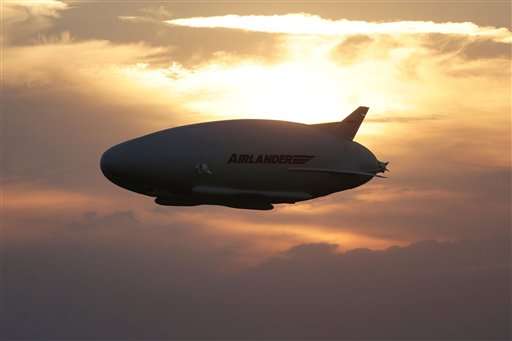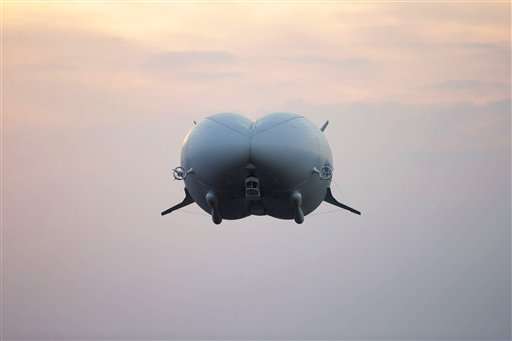Source: phys.org
Published: August 17, 2016

The Airlander 10 in flight, after taking off from Cardington airfield in Bedfordshire, England, Wednesday Aug. 17, 2016. A blimp-shaped airship billed as the world’s largest aircraft has taken off for the first time, days after an earlier attempt was scuttled by a last-minute technical hitch. The 302-foot (92-meter) Airlander 10—nicknamed the “flying bum” because of its bulbous front end—rose slowly into the air Wednesday from an airfield 45 miles (73 kilometers) north of London. (Yui Mok/PA via AP)
By Jill Lawless
A blimp-shaped, helium-filled airship considered the world’s largest aircraft flew for the first time Wednesday with a short but historic jaunt over an airfield in central England.
Engines roaring, the 302-foot (92-meter) Airlander 10 rose slowly into the air from Cardington airfield, 45 miles (73 kilometers) north of London.
A hybrid of blimp, helicopter and airplane, it can stay aloft for days at a time and has been nicknamed the “flying bum” because of its bulbous front end.
The stately aircraft performed a circuit of the area—watched by hundreds of local people who had parked their cars around the perimeter of the airfield—before touching down about half an hour later as dusk fell.
The Airlander is designed to use less fuel than a plane, but carry heavier loads than conventional airships. Its developer, Hybrid Air Vehicles, says it can reach 16,000 feet (4,900 meters), travel at up to 90 mph (148 kph) and stay aloft for up to two weeks.
“It’s a great British innovation,” said chief executive Stephen McGlennan. “It’s a combination of an aircraft that has parts of normal fixed-wing aircraft, it’s got helicopter, it’s got airship.”
The aircraft was initially developed for the U.S. military, which planned to use it for surveillance in Afghanistan. The U.S. blimp program was scrapped in 2013 and since then Hybrid Air Vehicles, a small British aviation firm that dreams of ushering in a new era for airships, has sought funding from government agencies and individual donors.
The vast aircraft is based at Cardington, where the first British airships were built during and after World War I. That program was abandoned after a 1930 crash that killed almost 50 people, including Britain’s air minister.

That accident and others—including the fiery 1937 crash in New Jersey of the Hindenburg, which killed 35—dashed the dream of the airship as a mode of transportation for decades.
Unlike hydrogen, the gas used in the Hindenburg, helium is not flammable.
Wednesday’s flight came days after a test flight planned for Sunday was scrapped at the last minute because of an unspecified technical issue.
The successful journey was a milestone in the development of a vehicle that remains untested as a commercial proposition.
McGlennan is confident there will be plenty of customers for Airlander—both civilian and military—because of its potential to gather data and conduct surveillance for days on end.
It can also carry up to 10 metric tons (22,050 pounds) of passengers or cargo. The company hopes to have an even bigger aircraft, capable of carrying 50 metric tons (110,000 pounds), in service by the early 2020s.
McGlennan said Airlander has many of the assets of a helicopter. It can “provide air transportation for people and goods without the need for a runway. But this thing can take more over longer distances, it’s cheaper and it’s greener.”
Chris Pocock, defense editor of aviation magazine AIN, said the jury is still out on whether the craft is commercially viable.
“Airships and hybrids have still got a credibility gap to cover,” he said. “Technically I think they are there now, but economically I’m not so sure.”
